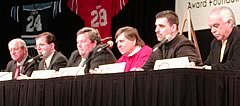Before the drama of the Hobey Baker and Humanitarian awards presentations, USCHO.com sponsored its second annual Town Meeting on the state of college hockey Friday at the Touchstone Energy Center.
The commissioners from the six Division I hockey conferences answered live questions from fans in attendance on subjects ranging from the regionalization of the sport to the mechanics of expanding the championship tournament to 16 teams.
Building off the success of the inaugural Town Meeting at the Frozen Four in Albany, N.Y., this year’s event was better attended with thoughtful queries by college hockey’s faithful.
“I want to thank the staff of USCHO and the fans for taking their time in appearing today,” said CCHA commissioner Tom Anastos. “We love your passion and appreciate what you do for the game.”
The event was hosted by USCHO general manager Jayson Moy; after brief introductions, the first question dealt with where the regionals might be held in a four-tiered tournament. WCHA commissioner Bruce McLeod explained that sites would be selected by trying to balance attendance and revenue requirements with the desire not to give an unfair advantage to any campus site hosting.
“In the East you have a lot of neutral buildings that serve very well,” he said. “We don’t have those facilities in the West … At Ann Arbor this year you saw what advantage that situation then gives to the home team. We had the number-one seed, Denver, play the number four seed in their building. Is that fair?”
The high point of the 35-minute session came when a question was posed about the East-West split in the game, and the fact that rarely does one half of the country see the other half play. The sextet was brutally honest with its frustration about landing a television deal to help nationalize the game.
“As commissioners we have had two priorities: expand the tournament to 16 teams and make a national television presence,” said Hockey East commissioner Joe Bertagna.

“We’ve all talked to the people at ESPN and FOX. They’ve offered us airtime if we move the games to midweek and in the late afternoon. We’d also be responsible for raising the revenue to produce the game up to their standards. No national sponsors will put their product on a broadcast.”
“Reality slaps us in the face,” McLeod added. “The NHL has made progress in putting teams in California, Florida, and Texas. We’re much more regionalized than they are, and [the NHL] struggles with ratings big-time. We work constantly to put something through.”
Other topics concerned the expansion of the game. One of the driving forces behind the expansion of the NCAA tournament has been the addition of over 20 Division I programs over the last few years.
This prospect had fans wondering about other schools, such as Syracuse, Penn State, and Eastern Michigan, that are mulling adding D-I programs and where they would fit in the conference structure.
“There are currently 162 club teams in the nation and we have discussed with them and have invited their athletic and academic leadership to join us,” said CHA commissioner R.H. “Bob” Peters. “The CHA is the youth conference with only six teams, and our members have discussed expansion — at a maximum we want 12 teams, and at a minimum eight.”
While the WCHA, CCHA, and Hockey East balked at increasing their membership, the MAAC, CHA, and even the 12-team ECAC would be open to new teams.
“Provided we could work out travel partner situations, a team like Syracuse with seem to fit along with our other programs like Cornell and Colgate,” said ECAC assistant commissioner Steve Hagwell.
The group concurred that while enrollment may be limited in the existing conferences, they would welcome the development of more mid-major conferences, as in basketball.
“Expanding our sport is a real priority,” Anastos said. “We’ve been very supportive of the new conferences. We want to see the grand game grow.”
The final topic of discussion was offered by a Northeastern fan, inspired in part by witnessing the 15,000-plus throng of Minnesota supporters that flocked to the Xcel Energy Center Thursday. He asked if schools entering the D-I level need the 10,000-plus supporters and the revenue they bring to compete.
Rich Ensor, the MAAC commissioner, emphatically disputed that notion:
“Our economic model is based on us not needing large crowds,” he said. “We don’t draw 10,000 for basketball, either. Our funding isn’t based on ticket revenue, but is part of our school’s general budget. We can be competitive without being extravagant.”
Hagwell and Bertagna both noted that the schools in the East do not have the new facilities that have been popping up across the Midwest. Few Eastern schools have anything like North Dakota’s new Engelstad Arena, with its marble Sioux head. But Hagwell was willing to rate the Cornell crowd at Lynah Rink with any in the nation.
Bertagna conceded that the new buildings allow teams advantages in tournaments they can host and the structure of their nonconference schedules, but he defended the Walter Brown Arenas of the East.
“We can’t forget the history of our game as coming from small, northern campuses,” he said. “Just because there are no Taj Mahals being built [in the East], it is still special on a Saturday night to see the small, older buildings filled for college hockey.”
Fans whom time precluded the opportunity to ask questions were permitted to submit them in writing to the commissioners, who promised to answer them.


